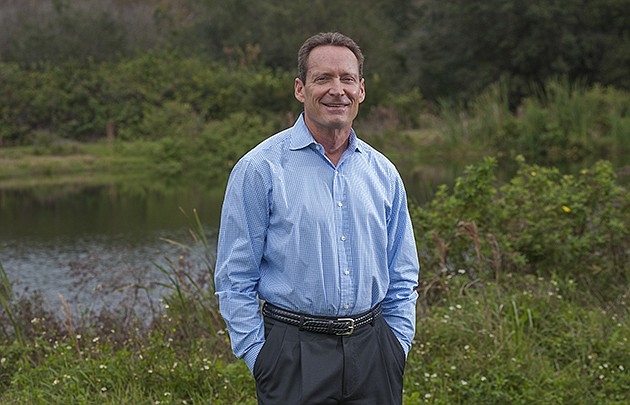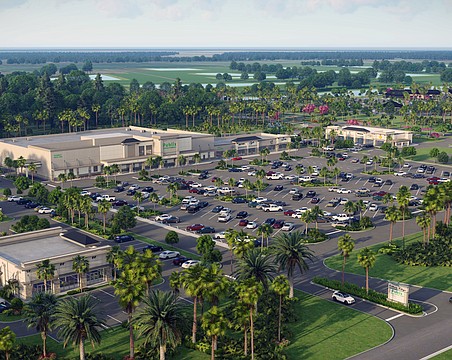Most developers engaged in new office park or campus construction focus almost exclusively on landing as many tenants as possible before turning their attention to connected amenities like restaurants or recreational activities.
But not Schroeder-Manatee Ranch and its Lakewood Ranch Commercial Realty affiliate.
Instead, the master developer of Lakewood Ranch intends to build amenities first in an effort to attract corporate and research-oriented tenants to its planned 265-acre life sciences campus.
CORE at Lakewood Ranch is being designed to contain as much as 4.5 million square feet of commercial and educational space — roughly equivalent to the 108-story Willis Tower skyscraper in Chicago — when fully built out.
The ambitious development plan also includes a hotel and conference facility capable of accommodating more than 1,000 people at a time — a long-standing and as-yet unaccomplished goal of tourism and civic promoters in Sarasota and Manatee counties alike.

Backers say CORE — Collaboration Opportunities for Research and Exploration — could galvanize the region's burgeoning life sciences industry and help transform the Gulf Coast by shifting away from traditional economic drivers like tourism and real estate for decades to come.
Before that occurs, though, Lakewood Ranch Commercial plans to build restaurants, retail shops like an organic grocery store, a health club and a host of other amenities.
Kirk Boylston, president of Lakewood Ranch Commercial, says construction on an initial 40,000 square feet of retail, restaurant and related space could begin by the end of this year, with delivery in 2017.
“We're very fortunate to be able to do the amenities up front,” Boylston says. “It'll be a big leg up for us, because the package of amenities won't just be something we'll be promising in the future — they'll be here for prospective tenants to see.”
Boylston also promises CORE's restaurants will be concepts aimed primarily at park employees, with a focus on wellness and organic offerings.
The park's overall design from Wisconsin-based Flad Architects will depart from Lakewood Ranch's typical schematics, too, in that it will be less Mediterranean Revival and more modern, he adds.
Boylston hopes CORE's first life sciences tenant will move into the park around the same time the first wave of amenities are completed. He said a deal for an anchor tenant for a planned 50,000-square-foot building to kick off the park could be announced as early as April.
If that reaches fruition, Boylston hopes to leverage the deal to generate momentum and critical mass to land a university that would either bring a research hospital or some other major educational presence to CORE.
He believes the presence of the Mayo and Cleveland clinics in Jacksonville and Fort Lauderdale, respectively, as well as Johns Hopkins University's partnership with All Children's Hospital, in St. Petersburg, have set a precedent for such moves by major institutions to Florida.
“We want someone like that, and we'd want them here in a major way,” he says. “We're absolutely focused on that.”
But Lakewood Ranch officials acknowledge, as well, that creating a life sciences campus from scratch has pitfalls, especially in competing against more established cities like Boston, San Francisco and the Baltimore/Washington corridor.
Life sciences parks also exist throughout Florida, at the University of South Florida and elsewhere.
Still, CORE participants contend Lakewood Ranch has attributes other places don't.
“It's not going to be easy, like any development, but Sarasota and the surrounding community have a lot to offer that's very unique,” says Steve Jackson, the Flad Architects designer who is working with Lakewood Ranch to bring CORE to life.
“Mote Marine and Roskamp, among others, have been very successful in that area, and Lakewood Ranch is one of the fastest-growing master planned communities in the U.S.,” Jackson adds. “This will only add to what they're doing there.”
If a university presence does come to CORE, such a facility could anchor the entire park and lead to what Boylston believes would ultimately contain a mix of uses tangentially tied to life sciences.
“There's a lot of life sciences in our community already,” Boylston says. “But it's been scattered to date because there's never been a place for it to aggregate.”
Clustering would help prospective tenants, as well, he says, by allowing for the easy sharing of ideas, personnel and equipment.
Boylston notes, too, that CORE wouldn't be limited to research clinics and academics. The campus could ultimately be home to pharmaceutical companies, health care-related data and IT firms, medical device makers or other health care entities.
“Life sciences has a pretty broad spectrum of services associated with it,” Boylston says. “But we have the pieces in place already to make this work. We have a good educational base already, and four universities and colleges that are committed to working together now.”
At least one critical piece is already in place: power.
Last year, Florida Power & Light designated the ranch as one of four “data centers” in the state, together with Palm Beach, Jacksonville and Miami. The designation means Lakewood Ranch has, or can obtain, the necessary infrastructure for fiber optic and electricity expansion to meet the needs of future life sciences users.
Boylston says being able to deliver adequate power could be a major advantage to luring medical or science tenants to CORE.
“Data is a big and growing part of the industry nowadays,” Boylston says. “And a lot of power is needed to run and cool the computers and servers that those users will require.”
Eventually, Lakewood Ranch Commercial hopes to augment the campus with as many as 300 apartments or condominiums and an equal number of hotel rooms connected to a conference facility that would flank a series of mid-rise office and research buildings.
“Locationally, we'd be much easier to get to than some of the other proposed sites, and we have necessary amenities in place,” Boylston says of the meeting space, which has been proposed for years in downtown Sarasota and in Manatee County.
“But we're not so focused on that right now, because we think it would require some government participation,” he adds.
For now, ranch officials say they are leveraging contacts and spreading the word about CORE to generate leads.
“In terms of economic diversity, with our demographics and the state's aging population, life sciences would be a good thing for this community to focus on: It's clean industry and typically offers higher paying jobs that will help us as a community retain younger workers,” Boylston says.







